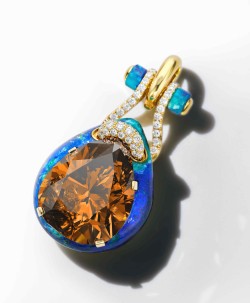
Sotheby’s will offer two diamonds weighing more than 100 carats at its upcoming jewelry sale, with one expected to fetch in excess of $10 million.
The Juno diamond, a pear-shaped, 101.41-carat, D-color, internally flawless, type IIa stone, will lead the June 16 New York Magnificent Jewels sale, the auction house said last week. Only 11 D-color diamonds over 100 carats have ever been sold at auction, Sotheby’s noted.
That stone will be joined by the Earth Star, a pear-shaped, 111.59-carat, fancy-deep-orange-brown diamond, which has returned to the auction block for the first time in nearly 40 years. The piece, which is the second-largest diamond of its color, cut and size to be offered at an auction, carries a high estimate of $2.5 million.

Designer David Webb has created a custom mounting for the stone, which was fashioned from a 248-carat rough discovered at the Jagersfontein mine in South Africa in 1967. The setting uses azurmalachite to resemble the Earth as seen from the perspective of a star, Sotheby’s explained.
Other notable items include an emerald-cut, 26.06-carat, D-color, VVS1-clarity diamond ring by Kwiat, which is estimated at up to $3 million, and a pair of diamond and sapphire earrings. The set features two pear-shaped, D-flawless diamonds weighing 4.09 and 4.12 carats; two emerald-cut, D-color diamonds weighing 3.19 and 3.17 carats; and two Kashmir sapphires weighing 9.65 and 9.44 carats. It is predicted to realize up to $3 million. Meanwhile, an Indian-inspired emerald and diamond fringe necklace by Cartier made in 1945 has a price tag of $1.5 million to $2.5 million.
Source: DCLA







